#api connectors
Explore tagged Tumblr posts
Text
Quickwork guides you through the world of customer support automation, offering valuable insights and tools to enhance your support processes, boost efficiency, and improve customer satisfaction. More at https://bit.ly/46MkEKm
0 notes
Text
Connect SMSGatewayCenter SMS & WhatsApp API with MoEngage | Step-by-Step
Learn how to integrate SMSGatewayCenter’s SMS and WhatsApp Business API with MoEngage as a custom connector! 📱 This step-by-step tutorial guides you through setting up seamless, TRAI-compliant SMS and WhatsApp campaigns for your business. Perfect for marketers, developers, and businesses in India looking to boost engagement with personalized messaging. 🚀 Follow along and start automating your campaigns today with SMSGatewayCenter!
👉 Get started: https://www.smsgatewaycenter.com/
📢 Subscribe for more tutorials: https://www.youtube.com/@SMS.Gateway.Center
💬 Have questions? Drop them in the comments!
🔗 Related guide: https://www.smsgatewaycenter.com/integrations/connect-moengage-sms/
#SMSGatewayCenter#MoEngage integration#bulk SMS API#WhatsApp Business API#SMS marketing#WhatsApp marketing#DLT compliance#TRAI regulations#custom connector#SMS campaigns#WhatsApp campaigns#business automation#Mumbai businesses#digital marketing#API integration#SMS Gateway Center#MoEngage tutorial#SMS for business#WhatsApp for business
1 note
·
View note
Text
Power Platform als verbundener Dienst für Visual Studio ist allgemein verfügbar
Power Platform, Visual Studio 2022, Custom Connectors, Microsoft Power Apps, API, ASP.NET Core Web API, Power Platform CLI, Canvas-App, Power Fx, mobiles Erlebnis, Legacy-APIs, Marcel Ferreira
Ich bin auf den Autor Marcel Ferreira aufmerksam geworden. Mit meinem Beitrag möchte ich auf seine spannende Ankündigung aufmerksam machen, die für Entwickler von großem Interesse sein dürfte. Während der Microsoft Build 2023 wurde die Möglichkeit angekündigt, benutzerdefinierte Connectors innerhalb von Visual Studio zu erstellen, um schnell eine Front-End für Ihre API mit Microsoft Power Apps…

View On WordPress
#API#ASP.NET Core Web API#Canvas-App#Custom Connectors#Legacy-APIs#Marcel Ferreira#Microsoft Power Apps#mobiles Erlebnis#Power Fx#Power Platform#Power Platform CLI#Visual Studio 2022
0 notes
Text

No-Code API Connector Service Provider-Cloud Revolute
0 notes
Text
Amazon Web Service & Adobe Experience Manager:- A Journey together (Part-5)
In the previous parts (1,2,3 & 4) we discussed how one day digital market leader meet with the a friend AWS in the Cloud and become very popular pair. It bring a lot of gifts for the digital marketing persons. Then we started a journey into digital market leader house basement and structure, mainly repository CRX and the way its MK organized. Ways how both can live and what smaller modules they used to give architectural benefits.Also visited how the are structured together to give more.
In this part as well will see on the more in architectural side.
AEM scale in the cloud
A dynamic architecture with a variable number of AEM images is required to fulfill the operational business needs.
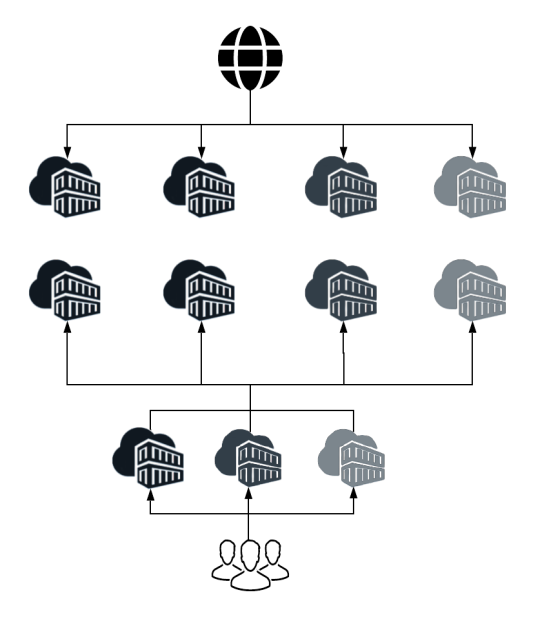
AEM as a Cloud Service is based on the use of an orchestration engine.Dynamically scales each of the service instances as per the actual needs; both scaling up or down as appropriate.
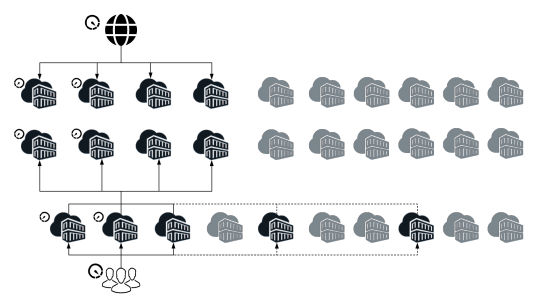
Scaling is a very simple task in AWS with creating separate Amazon Machine Images(AMIs) for publish , publish-dispatcher and author- dispatcher instance.
Use an AMI
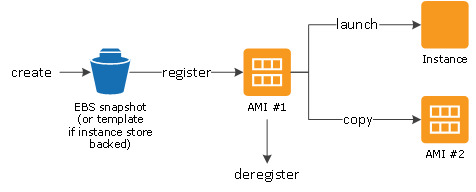
Three separate launch configurations can be created using these AMIs and included in separate Auto Scaling groups(Auto Scaling groups - Amazon EC2 Auto Scaling).
AWS Lambda can provide scaling logic for scale up/down events from Auto Scaling groups.
Scaling logic consists of pairing/unpairing the newly launched dispatcher instance to an available publish instance or vice versa, updating the replication agent (reverse replication, if applicable) between the newly launched publish and author, and updating AEM content health check alarms.
One more approach for the quicker startup and synchronization, AEM installation can place on a separate EBS volume. A frequent snapshots of the volume and attachment to the newly-launched instances, Cut-down need of replicate large amounts of author data. Also it ensure the latest content.
CDN:-Content Delivery Network or Content Distribution Network
A CDN is a group of geographically distributed and interconnected servers. They provide cached internet content from a network location closest to a user to speed up its delivery.
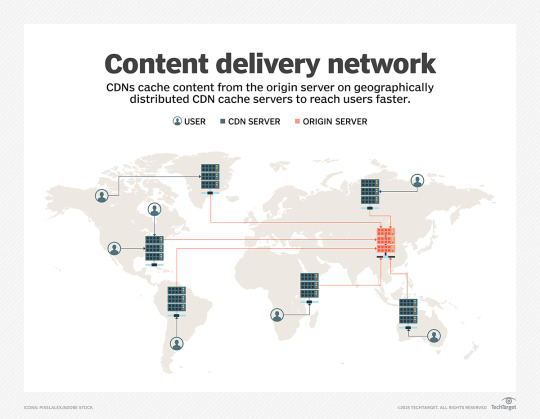
AWS is having answer of CDN requirement as well in the form of Amazon CloudFront a Low-Latency Content Delivery Network (CDN)
How it works
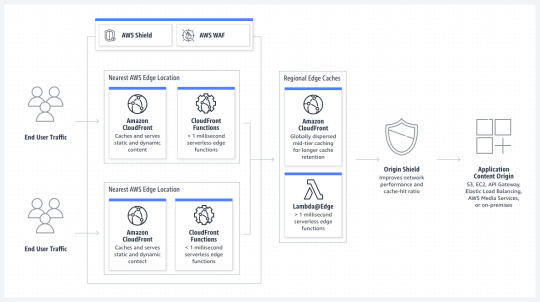
It will act as an additional caching layer with AEM dispatcher. Also it require proper content invalidation when it refreshed.
Explicit configuration of duration of particular resources are held in the CloudFront cache, expiration and cache-control headers sent by dispatcher required to control caching into CloudFront .
Cache control headers controlled by using mod_expires Apache Module.
Another approach will be API-based invalidation a custom invalidation workflow and set up an AEM Replication Agent that will use your own ContentBuilder and TransportHandler to invalidate the Amazon CloudFront cache using API.
These all about caching of static content only what is the solution or way to handle Dynamic content will see now.
Content which is Dynamic in Nature
Dispatcher is the key element of caching layer with the AEM. But it will not give full benefit when complete page is not cacheable. Now the question arise how dynamic content can fit into page without breaking the caching feature. There are some standard suggestion available. Like Edge Side Includes (ESIs),client-side JavaScript or Server Side Includes (SSIs) incorporate dynamic elements in a static page.
AWS is also have one solution as Varnish(replacing the dispatcher) to handle ESIs . But its not recommended by Adobe.
Till here we have seen structure of content dynamic static and various ways, but digital solution also have huge number of Assets mainly binary data. These need to configure handle properly to ensure performance of the site.
Again AWS is equipped with great solution called Amazon S3.
AEM Data Store with Amazon S3
Adobe Experience Manager (AEM), binary data can be stored independently from the content nodes. The binary data is stored in a data store, whereas content nodes are stored in a node store.
Both data stores and node stores can be configured using OSGi configuration. Each OSGi configuration is referenced using a persistent identifier (PID).
AEM can be configured to store data in Amazon’s Simple Storage Service (S3), with following PID for configuration
org.apache.jackrabbit.oak.plugins.blob.datastore.S3DataStore.config
To enable the S3 data store functionality, a feature pack containing the S3 Datastore Connector must be downloaded and installed. For more detail please refer Configuring node stores and data stores in AEM 6 | Adobe Experience Manager
This will simplifying management and backups. Also, sharing of binary data store across author and between author & publish instances will be possible and easier task with AWS S3 solution. it will reduce overall storage and data transfer requirements.
Already this great combination walkthroug of the structure combination posibbilities , we will see one more variation available for the Cloud version of AEM with AWS in next (AEM OpenCloud)
Thanks for being with me till this , we will meet in next part with some amazing journey of OpenClode.
Hope you enjoy most till this part, kindly keep your blessings and love to motivate me.
Continue............
#aem#aws#adobe#cloud#wcm#programing#ELB#Amzon S3#OpenClode#OSGi#SSIs#ESI#CloudFront#Datastore#connector#Dispatcher#API#ContentBuilder#TransportHandler#CDN#AWS Lambda#aws lambda#Amazon EC2 Auto Scaling#ASG Auto Scaling Group#Amazon Machine Images(AMIs)#AEM AUTHOR#AEM Publish
1 note
·
View note
Note
hi, I was wanting to try out modding Minecraft but I'm a little lost lol and I don't know where to start. What mods do you like to play with? What's the difference between fabric and forge?
Fabric and Forge are two different modloaders! They're programs that allows Minecraft to understand the code being added to it. However, they do this in different ways, and when you make a mod, you need to start with a modloader as a base. So a mod made in Fabric won't necessarily work in Forge. There are some addons you can get that will make some Fabric mods load in Forge, like Connector, Cloth API, and Forgified Fabric API, but it's no guarantee.
5 notes
·
View notes
Text
Me: nervously submits a pull request for all the work I've been doing for the past month involving multiple apis and internal connectors I've built from scratch and just so so much opportunity for extreme fuckupage
My boss: minutes later approves and merges everything in one giant sweep WHILE IN A MEETING SO I KNOW DAMN BLOODY WELL YOU DIDN'T LOOK AT EVEN A SINGLE LINE
I appreciate the vote of confidence here but Code Father why must you refuse to aid me in avoiding your disappointment why do you leave this door open Code Father please
23 notes
·
View notes
Text
youtube
Desk of Ladyada - I2S DACs, Claude API, and Compute Module Backpack 🤖🎒🥧 https://youtu.be/XihMNhTyUlg
Ladyada explores I2S DACs, testing PCM51xx as a UDA1334A alternative. Work continues on the TLV320DAC3100, we test an AI API interface for setters/getters for Claude with pay per token. A new Pi Compute Module backpack is in progress - And we search for tall connectors for CM4/CM5.
#i2s#dac#raspberrypi#pcm5102#tlv320dac3100#compute#embedded#hardwaredesign#electronics#maker#opensource#adafruit#audiophile#tech#engineering#aiapi#claude#prototype#cm4#cm5#computemodule#raspberrypicm#pcbdesign#connectors#digikey#electronicsengineering#soldering#pcb#hardware#Youtube
4 notes
·
View notes
Text
Best Odoo Power BI Connector In Market: Full Comparative Analysis
In today’s fast-paced business environment, having a reliable ERP system isn’t just beneficial—it's essential. Odoo has made a name for itself with its flexible and integrated approach, offering a comprehensive suite of solutions for businesses of all sizes. If you're serious about getting insights that truly matter, connecting Odoo ERP with a powerful analytics tool like Microsoft Power BI is where the magic happens. By doing this, you can pull data from different areas of Odoo and create insightful dashboards, helping you make informed, data-driven decisions.
In this post, we'll take a closer look at the Power BI connectors available from top providers—Techfinna, Webkul, Cdata, and Cybrosys. Our goal is to help you navigate these options so you can find the right fit for your needs.
Why Consider a Power BI Connector for Odoo?
You might be asking yourself, “What’s the big deal about integrating Power BI with Odoo?” That’s a totally valid question! While Odoo offers a robust platform for managing your business, when it comes to advanced reporting and analytics, Power BI really stands out. Connecting these two tools can transform the way you analyze data.
Here’s why you should think about this integration:
Create Dynamic Dashboards: Imagine having real-time insights at your fingertips. Dynamic dashboards help you visualize your business data like never before.
Tailor Your Visuals: Every business has unique needs. With Power BI, you can customize your data visuals to tell the story that's most important for you and your team.
Dive Deep into Data Patterns: Tackling complex data can be daunting, but this integration allows you to uncover patterns that help drive strategic decisions.

In comparison, other providers like Webkul, CData, and Cybrosys offer decent solutions but lack the direct connectivity and easy integration that Techfinna provides. Techfinna is the best Odoo Power BI Connector due to its unique direct connection capability, allowing for flawless integration with Odoo and real-time data synchronization.
Conclusion
The Techfinna Power BI Connector is the top choice for businesses looking to enhance their analytics and reporting capabilities. Its direct connection capability, real-time synchronization, and user-friendly design make it the ideal solution for companies aiming to maximize their data’s potential.
While competitors offer viable API-based options, Techfinna’s connector delivers unmatched performance and efficiency, making it the preferred choice for Odoo and Power BI integration.
#odoo18#microsoft#power bi#technology#odoo#tech#odoo crm#odoo erp#powerbiintegratin#connector#odooconnector#odoopowerbi#microsoftpowerbi#odoointegraion
3 notes
·
View notes
Text
What is Argo CD? And When Was Argo CD Established?

What Is Argo CD?
Argo CD is declarative Kubernetes GitOps continuous delivery.
In DevOps, ArgoCD is a Continuous Delivery (CD) technology that has become well-liked for delivering applications to Kubernetes. It is based on the GitOps deployment methodology.
When was Argo CD Established?
Argo CD was created at Intuit and made publicly available following Applatix’s 2018 acquisition by Intuit. The founding developers of Applatix, Hong Wang, Jesse Suen, and Alexander Matyushentsev, made the Argo project open-source in 2017.
Why Argo CD?
Declarative and version-controlled application definitions, configurations, and environments are ideal. Automated, auditable, and easily comprehensible application deployment and lifecycle management are essential.
Getting Started
Quick Start
kubectl create namespace argocd kubectl apply -n argocd -f https://raw.githubusercontent.com/argoproj/argo-cd/stable/manifests/install.yaml
For some features, more user-friendly documentation is offered. Refer to the upgrade guide if you want to upgrade your Argo CD. Those interested in creating third-party connectors can access developer-oriented resources.
How it works
Argo CD defines the intended application state by employing Git repositories as the source of truth, in accordance with the GitOps pattern. There are various approaches to specify Kubernetes manifests:
Applications for Customization
Helm charts
JSONNET files
Simple YAML/JSON manifest directory
Any custom configuration management tool that is set up as a plugin
The deployment of the intended application states in the designated target settings is automated by Argo CD. Deployments of applications can monitor changes to branches, tags, or pinned to a particular manifest version at a Git commit.
Architecture
The implementation of Argo CD is a Kubernetes controller that continually observes active apps and contrasts their present, live state with the target state (as defined in the Git repository). Out Of Sync is the term used to describe a deployed application whose live state differs from the target state. In addition to reporting and visualizing the differences, Argo CD offers the ability to manually or automatically sync the current state back to the intended goal state. The designated target environments can automatically apply and reflect any changes made to the intended target state in the Git repository.
Components
API Server
The Web UI, CLI, and CI/CD systems use the API, which is exposed by the gRPC/REST server. Its duties include the following:
Status reporting and application management
Launching application functions (such as rollback, sync, and user-defined actions)
Cluster credential management and repository (k8s secrets)
RBAC enforcement
Authentication, and auth delegation to outside identity providers
Git webhook event listener/forwarder
Repository Server
An internal service called the repository server keeps a local cache of the Git repository containing the application manifests. When given the following inputs, it is in charge of creating and returning the Kubernetes manifests:
URL of the repository
Revision (tag, branch, commit)
Path of the application
Template-specific configurations: helm values.yaml, parameters
A Kubernetes controller known as the application controller keeps an eye on all active apps and contrasts their actual, live state with the intended target state as defined in the repository. When it identifies an Out Of Sync application state, it may take remedial action. It is in charge of calling any user-specified hooks for lifecycle events (Sync, PostSync, and PreSync).
Features
Applications are automatically deployed to designated target environments.
Multiple configuration management/templating tools (Kustomize, Helm, Jsonnet, and plain-YAML) are supported.
Capacity to oversee and implement across several clusters
Integration of SSO (OIDC, OAuth2, LDAP, SAML 2.0, Microsoft, LinkedIn, GitHub, GitLab)
RBAC and multi-tenancy authorization policies
Rollback/Roll-anywhere to any Git repository-committed application configuration
Analysis of the application resources’ health state
Automated visualization and detection of configuration drift
Applications can be synced manually or automatically to their desired state.
Web user interface that shows program activity in real time
CLI for CI integration and automation
Integration of webhooks (GitHub, BitBucket, GitLab)
Tokens of access for automation
Hooks for PreSync, Sync, and PostSync to facilitate intricate application rollouts (such as canary and blue/green upgrades)
Application event and API call audit trails
Prometheus measurements
To override helm parameters in Git, use parameter overrides.
Read more on Govindhtech.com
#ArgoCD#CD#GitOps#API#Kubernetes#Git#Argoproject#News#Technews#Technology#Technologynews#Technologytrends#govindhtech
2 notes
·
View notes
Text
Discover how Quickwork simplifies the process of creating Slack integrations, automating your business operations. Empower your team with efficient, customized workflows and boost productivity effortlessly. More at https://bit.ly/3MhpIhw
0 notes
Text
Build a Seamless Crypto Exchange Experience with Binance Clone Software

Binance Clone Script
The Binance clone script is a fully functional, ready-to-use solution designed for launching a seamless cryptocurrency exchange. It features a microservice architecture and offers advanced functionalities to enhance user experience. With Plurance’s secure and innovative Binance Clone Software, users can trade bitcoins, altcoins, and tokens quickly and safely from anywhere in the world.
This clone script includes essential features such as liquidity APIs, dynamic crypto pairing, a comprehensive order book, various trading options, and automated KYC and AML verifications, along with a core wallet. By utilizing our ready-to-deploy Binance trading clone, business owners can effectively operate a cryptocurrency exchange platform similar to Binance.
Features of Binance Clone Script
Security Features
AML and KYC Verification: Ensures compliance with anti-money laundering and know-your-customer regulations.
Two-Factor Authentication: Provides an additional security measure during user logins.
CSRF Protection: Shields the platform from cross-site request forgery threats.
DDoS Mitigation: Safeguards the system against distributed denial-of-service attacks.
Cloudflare Integration: Enhances security and performance through advanced web protection.
Time-Locked Transactions: Safeguards transactions by setting time limits before processing.
Cold Wallet Storage: Keeps the majority of funds offline for added security.
Multi-Signature Wallets: Mandates multiple confirmations for transactions, boosting security.
Notifications via Email and SMS: Keeps users informed of account activities and updates.
Login Protection: Monitors login attempts to detect suspicious activity.
Biometric Security: Utilizes fingerprint or facial recognition for secure access.
Data Protection Compliance: Adheres to relevant data privacy regulations.
Admin Features of Binance Clone Script
User Account Management: Access detailed user account information.
Token and Cryptocurrency Management: Add and manage various tokens and cryptocurrencies.
Admin Dashboard: A comprehensive interface for managing platform operations.
Trading Fee Setup: Define and adjust trading fees for transactions.
Payment Gateway Integration: Manage payment processing options effectively.
AML and KYC Oversight: Monitor compliance processes for user verification.
User Features of Binance Clone Script
Cryptocurrency Deposits: Facilitate easy deposit of various cryptocurrencies.
Instant Buy/Sell Options: Allow users to trade cryptocurrencies seamlessly.
Promotional Opportunities: Users can take advantage of promotional features to maximize profits.
Transaction History: Access a complete record of past transactions.
Cryptocurrency Wallet Access: Enable users to manage their digital wallets.
Order Tracking: Keep track of buy and sell orders for better trading insights.
Binance Clone Development Process
The following way outline how our blockchain experts develop a largely effective cryptocurrency exchange platform inspired by Binance.
Demand Analysis
We begin by assessing and gathering your business conditions, similar as the type of trades you want to grease, your target followership, geographical focus, and whether the exchange is intended for short-term or long-term operation.
Strategic Planning
After collecting your specifications, our platoon formulates a detailed plan to effectively bring your ideas to life. This strategy aims to deliver stylish results acclimatized to your business requirements.
Design and Development
Our inventors excel in UI/ UX design, creating visually appealing interfaces. They draft a unique trading platform by exercising the rearmost technologies and tools.
Specialized perpetration
Once the design is complete, we concentrate on specialized aspects, integrating essential features similar to portmanteau connectors, escrow services, payment options, and robust security measures to enhance platform functionality.
Quality Assurance Testing
After development, we conduct thorough testing to ensure the exchange platform operates easily. This includes security assessments, portmanteau and API evaluations, performance testing, and vindicating the effectiveness of trading machines.
Deployment and Support
Following successful testing, we do with the deployment of your exchange platform. We also gather stoner feedback to make advancements and introduce new features, ensuring the platform remains robust and over-to-date.
Revenue Streams of a Binance Clone Script
Launching a cryptocurrency exchange using a robust Binance clone can create multiple avenues for generating revenue.
Trading Fees
The operator of the Binance clone platform has the discretion to set a nominal fee on each trade executed.
Withdrawal Charges
If users wish to withdraw their cryptocurrencies, a fee may be applied when they request to transfer funds out of the Binance clone platform.
Margin Trading Fees
With the inclusion of margin trading functionalities, fees can be applied whenever users execute margin transactions on the platform.
Listing Fees
The platform owner can impose a listing fee for users who want to feature their cryptocurrencies or tokens on the exchange.
Referral Program
Our Binance clone script includes a referral program that allows users to earn commissions by inviting friends to register on the trading platform.
API Access Fees
Developers can integrate their trading bots or other applications by paying for access to the platform’s API.
Staking and Lending Fees
The administrator has the ability to charge fees for services that enable users to stake or lend their cryptocurrencies to earn interest.
Launchpad Fees
The Binance clone software offers a token launchpad feature, allowing the admin to charge for listing and launching new tokens.
Advertising Revenue
Similar to Binance, the trading platform can also generate income by displaying advertisements to its users.
Your Path to Building a Crypto Exchange Like Binance
Take the next step toward launching your own crypto exchange similar to Binance by collaborating with our experts to establish a robust business ecosystem in the cryptocurrency realm.
Token Creation
Utilizing innovative fundraising methods, you can issue tokens on the Binance blockchain, enhancing revenue generation and providing essential support for your business.
Staking Opportunities
Enable users to generate passive income by staking their digital assets within a liquidity pool, facilitated by advanced staking protocols in the cryptocurrency environment.
Decentralized Swapping
Implement a DeFi protocol that allows for the seamless exchange of tokenized assets without relying on a central authority, creating a dedicated platform for efficient trading.
Lending and Borrowing Solutions
Our lending protocol enables users to deposit funds and earn annual returns, while also offering loans for crypto trading or business ventures.
NFT Minting
Surpass traditional cryptocurrency investments by minting a diverse range of NFTs, representing unique digital assets such as sports memorabilia and real estate, thereby tapping into new market values.
Why Should You Go With Plurance's Ready-made Binance Clone Script?
As a leading cryptocurrency exchange development company, Plurance provides an extensive suite of software solutions tailored for cryptocurrency exchanges, including Binance scripts, to accommodate all major platforms in the market. We have successfully assisted numerous businesses and entrepreneurs in launching profitable user-to-admin cryptocurrency exchanges that rival Binance.
Our team consists of skilled front-end and back-end developers, quality analysts, Android developers, and project engineers, all focused on bringing your vision to life. The ready-made Binance Clone Script is meticulously designed, developed, tested, and ready for immediate deployment.
Our committed support team is here to help with any questions you may have about the Binance clone software. Utilizing Binance enables you to maintain a level of customization while accelerating development. As the cryptocurrency sector continues to evolve, the success of your Binance Clone Script development will hinge on its ability to meet customer expectations and maintain a competitive edge.
#Binance Clone Script#Binance Clone Software#White Label Binance Clone Software#Binance Exchange Clone Script
2 notes
·
View notes
Text
Top 5 Selling Odoo Modules.
In the dynamic world of business, having the right tools can make all the difference. For Odoo users, certain modules stand out for their ability to enhance data management and operations. To optimize your Odoo implementation and leverage its full potential.
That's where Odoo ERP can be a life savior for your business. This comprehensive solution integrates various functions into one centralized platform, tailor-made for the digital economy.
Let’s drive into 5 top selling module that can revolutionize your Odoo experience:
Dashboard Ninja with AI, Odoo Power BI connector, Looker studio connector, Google sheets connector, and Odoo data model.
1. Dashboard Ninja with AI:
Using this module, Create amazing reports with the powerful and smart Odoo Dashboard ninja app for Odoo. See your business from a 360-degree angle with an interactive, and beautiful dashboard.
Some Key Features:
Real-time streaming Dashboard
Advanced data filter
Create charts from Excel and CSV file
Fluid and flexible layout
Download Dashboards items
This module gives you AI suggestions for improving your operational efficiencies.
2. Odoo Power BI Connector:
This module provides a direct connection between Odoo and Power BI Desktop, a Powerful data visualization tool.
Some Key features:
Secure token-based connection.
Proper schema and data type handling.
Fetch custom tables from Odoo.
Real-time data updates.
With Power BI, you can make informed decisions based on real-time data analysis and visualization.
3. Odoo Data Model:
The Odoo Data Model is the backbone of the entire system. It defines how your data is stored, structured, and related within the application.
Key Features:
Relations & fields: Developers can easily find relations ( one-to-many, many-to-many and many-to-one) and defining fields (columns) between data tables.
Object Relational mapping: Odoo ORM allows developers to define models (classes) that map to database tables.
The module allows you to use SQL query extensions and download data in Excel Sheets.
4. Google Sheet Connector:
This connector bridges the gap between Odoo and Google Sheets.
Some Key features:
Real-time data synchronization and transfer between Odoo and Spreadsheet.
One-time setup, No need to wrestle with API’s.
Transfer multiple tables swiftly.
Helped your team’s workflow by making Odoo data accessible in a sheet format.
5. Odoo Looker Studio Connector:
Looker studio connector by Techfinna easily integrates Odoo data with Looker, a powerful data analytics and visualization platform.
Some Key Features:
Directly integrate Odoo data to Looker Studio with just a few clicks.
The connector automatically retrieves and maps Odoo table schemas in their native data types.
Manual and scheduled data refresh.
Execute custom SQL queries for selective data fetching.
The Module helped you build detailed reports, and provide deeper business intelligence.
These Modules will improve analytics, customization, and reporting. Module setup can significantly enhance your operational efficiency. Let’s embrace these modules and take your Odoo experience to the next level.
Need Help?
I hope you find the blog helpful. Please share your feedback and suggestions.
For flawless Odoo Connectors, implementation, and services contact us at
[email protected] Or www.techneith.com
#odoo#powerbi#connector#looker#studio#google#microsoft#techfinna#ksolves#odooerp#developer#web developers#integration#odooimplementation#crm#odoointegration#odooconnector
4 notes
·
View notes
Text
TrueDialog
Website: https://powerautomate.microsoft.com/en-us/connectors/details/shared_truedialogsms/truedialog-sms/ Address: Austin, Texas TrueDialog is a cutting-edge communications-as-a-service company specializing in scalable, personalized messaging solutions for enterprises, educational, and non-profit institutions. With over a decade of experience, TrueDialog boasts direct carrier connections, a robust ISO 9001 cloud platform, and a suite of features tailored to customer needs. Their unique "TrueDialog" feature facilitates two-way, multi-user SMS conversations, while integration with major CRMs streamlines operations. TrueDialog offers specialized solutions for the education sector and provides a fully documented SMS API for developers, ensuring seamless customer engagement. #Communications#TrueDialog reviews Facebook: https://www.facebook.com/TrueDialog LinkedIn: https://www.linkedin.com/company/truedialog/ Twitter: https://twitter.com/TrueDialog

2 notes
·
View notes
Text
This Week in Rust 533
Hello and welcome to another issue of This Week in Rust! Rust is a programming language empowering everyone to build reliable and efficient software. This is a weekly summary of its progress and community. Want something mentioned? Tag us at @ThisWeekInRust on Twitter or @ThisWeekinRust on mastodon.social, or send us a pull request. Want to get involved? We love contributions.
This Week in Rust is openly developed on GitHub and archives can be viewed at this-week-in-rust.org. If you find any errors in this week's issue, please submit a PR.
Updates from Rust Community
Official
crates.io: API status code changes
Foundation
Google Contributes $1M to Rust Foundation to Support C++/Rust "Interop Initiative"
Project/Tooling Updates
Announcing the Tauri v2 Beta Release
Polars — Why we have rewritten the string data type
rust-analyzer changelog #219
Ratatui 0.26.0 - a Rust library for cooking up terminal user interfaces
Observations/Thoughts
Will it block?
Embedded Rust in Production ..?
Let futures be futures
Compiling Rust is testing
Rust web frameworks have subpar error reporting
[video] Proving Performance - FOSDEM 2024 - Rust Dev Room
[video] Stefan Baumgartner - Trials, Traits, and Tribulations
[video] Rainer Stropek - Memory Management in Rust
[video] Shachar Langbeheim - Async & FFI - not exactly a love story
[video] Massimiliano Mantione - Object Oriented Programming, and Rust
[audio] Unlocking Rust's power through mentorship and knowledge spreading, with Tim McNamara
[audio] Asciinema with Marcin Kulik
Non-Affine Types, ManuallyDrop and Invariant Lifetimes in Rust - Part One
Nine Rules for Accessing Cloud Files from Your Rust Code: Practical lessons from upgrading Bed-Reader, a bioinformatics library
Rust Walkthroughs
AsyncWrite and a Tale of Four Implementations
Garbage Collection Without Unsafe Code
Fragment specifiers in Rust Macros
Writing a REST API in Rust
[video] Traits and operators
Write a simple netcat client and server in Rust
Miscellaneous
RustFest 2024 Announcement
Preprocessing trillions of tokens with Rust (case study)
All EuroRust 2023 talks ordered by the view count
Crate of the Week
This week's crate is embedded-cli-rs, a library that makes it easy to create CLIs on embedded devices.
Thanks to Sviatoslav Kokurin for the self-suggestion!
Please submit your suggestions and votes for next week!
Call for Participation; projects and speakers
CFP - Projects
Always wanted to contribute to open-source projects but did not know where to start? Every week we highlight some tasks from the Rust community for you to pick and get started!
Some of these tasks may also have mentors available, visit the task page for more information.
Fluvio - Build a new python wrapping for the fluvio client crate
Fluvio - MQTT Connector: Prefix auto generated Client ID to prevent connection drops
Ockam - Implement events in SqlxDatabase
Ockam - Output for both ockam project ticket and ockam project enroll is improved, with support for --output json
Ockam - Output for ockam project ticket is improved and information is not opaque
Hyperswitch - [FEATURE]: Setup code coverage for local tests & CI
Hyperswitch - [FEATURE]: Have get_required_value to use ValidationError in OptionExt
If you are a Rust project owner and are looking for contributors, please submit tasks here.
CFP - Speakers
Are you a new or experienced speaker looking for a place to share something cool? This section highlights events that are being planned and are accepting submissions to join their event as a speaker.
RustNL 2024 CFP closes 2024-02-19 | Delft, The Netherlands | Event date: 2024-05-07 & 2024-05-08
NDC Techtown CFP closes 2024-04-14 | Kongsberg, Norway | Event date: 2024-09-09 to 2024-09-12
If you are an event organizer hoping to expand the reach of your event, please submit a link to the submission website through a PR to TWiR.
Updates from the Rust Project
309 pull requests were merged in the last week
add avx512fp16 to x86 target features
riscv only supports split_debuginfo=off for now
target: default to the medium code model on LoongArch targets
#![feature(inline_const_pat)] is no longer incomplete
actually abort in -Zpanic-abort-tests
add missing potential_query_instability for keys and values in hashmap
avoid ICE when is_val_statically_known is not of a supported type
be more careful about interpreting a label/lifetime as a mistyped char literal
check RUST_BOOTSTRAP_CONFIG in profile_user_dist test
correctly check never_type feature gating
coverage: improve handling of function/closure spans
coverage: use normal edition: headers in coverage tests
deduplicate more sized errors on call exprs
pattern_analysis: Gracefully abort on type incompatibility
pattern_analysis: cleanup manual impls
pattern_analysis: cleanup the contexts
fix BufReader unsoundness by adding a check in default_read_buf
fix ICE on field access on a tainted type after const-eval failure
hir: refactor getters for owner nodes
hir: remove the generic type parameter from MaybeOwned
improve the diagnostics for unused generic parameters
introduce support for async bound modifier on Fn* traits
make matching on NaN a hard error, and remove the rest of illegal_floating_point_literal_pattern
make the coroutine def id of an async closure the child of the closure def id
miscellaneous diagnostics cleanups
move UI issue tests to subdirectories
move predicate, region, and const stuff into their own modules in middle
never patterns: It is correct to lower ! to _
normalize region obligation in lexical region resolution with next-gen solver
only suggest removal of as_* and to_ conversion methods on E0308
provide more context on derived obligation error primary label
suggest changing type to const parameters if we encounter a type in the trait bound position
suppress unhelpful diagnostics for unresolved top level attributes
miri: normalize struct tail in ABI compat check
miri: moving out sched_getaffinity interception from linux'shim, FreeBSD su…
miri: switch over to rustc's tracing crate instead of using our own log crate
revert unsound libcore changes
fix some Arc allocator leaks
use <T, U> for array/slice equality impls
improve io::Read::read_buf_exact error case
reject infinitely-sized reads from io::Repeat
thread_local::register_dtor fix proposal for FreeBSD
add LocalWaker and ContextBuilder types to core, and LocalWake trait to alloc
codegen_gcc: improve iterator for files suppression
cargo: Don't panic on empty spans
cargo: Improve map/sequence error message
cargo: apply -Zpanic-abort-tests to doctests too
cargo: don't print rustdoc command lines on failure by default
cargo: stabilize lockfile v4
cargo: fix markdown line break in cargo-add
cargo: use spec id instead of name to match package
rustdoc: fix footnote handling
rustdoc: correctly handle attribute merge if this is a glob reexport
rustdoc: prevent JS injection from localStorage
rustdoc: trait.impl, type.impl: sort impls to make it not depend on serialization order
clippy: redundant_locals: take by-value closure captures into account
clippy: new lint: manual_c_str_literals
clippy: add lint_groups_priority lint
clippy: add new lint: ref_as_ptr
clippy: add configuration for wildcard_imports to ignore certain imports
clippy: avoid deleting labeled blocks
clippy: fixed FP in unused_io_amount for Ok(lit), unrachable! and unwrap de…
rust-analyzer: "Normalize import" assist and utilities for normalizing use trees
rust-analyzer: enable excluding refs search results in test
rust-analyzer: support for GOTO def from inside files included with include! macro
rust-analyzer: emit parser error for missing argument list
rust-analyzer: swap Subtree::token_trees from Vec to boxed slice
Rust Compiler Performance Triage
Rust's CI was down most of the week, leading to a much smaller collection of commits than usual. Results are mostly neutral for the week.
Triage done by @simulacrum. Revision range: 5c9c3c78..0984bec
0 Regressions, 2 Improvements, 1 Mixed; 1 of them in rollups 17 artifact comparisons made in total
Full report here
Approved RFCs
Changes to Rust follow the Rust RFC (request for comments) process. These are the RFCs that were approved for implementation this week:
No RFCs were approved this week.
Final Comment Period
Every week, the team announces the 'final comment period' for RFCs and key PRs which are reaching a decision. Express your opinions now.
RFCs
No RFCs entered Final Comment Period this week.
Tracking Issues & PRs
[disposition: merge] Consider principal trait ref's auto-trait super-traits in dyn upcasting
[disposition: merge] remove sub_relations from the InferCtxt
[disposition: merge] Optimize away poison guards when std is built with panic=abort
[disposition: merge] Check normalized call signature for WF in mir typeck
Language Reference
No Language Reference RFCs entered Final Comment Period this week.
Unsafe Code Guidelines
No Unsafe Code Guideline RFCs entered Final Comment Period this week.
New and Updated RFCs
Nested function scoped type parameters
Call for Testing
An important step for RFC implementation is for people to experiment with the implementation and give feedback, especially before stabilization. The following RFCs would benefit from user testing before moving forward:
No RFCs issued a call for testing this week.
If you are a feature implementer and would like your RFC to appear on the above list, add the new call-for-testing label to your RFC along with a comment providing testing instructions and/or guidance on which aspect(s) of the feature need testing.
Upcoming Events
Rusty Events between 2024-02-07 - 2024-03-06 🦀
Virtual
2024-02-07 | Virtual (Indianapolis, IN, US) | Indy Rust
Indy.rs - Ezra Singh - How Rust Saved My Eyes
2024-02-08 | Virtual (Charlottesville, NC, US) | Charlottesville Rust Meetup
Crafting Interpreters in Rust Collaboratively
2024-02-08 | Virtual (Nürnberg, DE) | Rust Nüremberg
Rust Nürnberg online
2024-02-10 | Virtual (Krakow, PL) | Stacja IT Kraków
Rust – budowanie narzędzi działających w linii komend
2024-02-10 | Virtual (Wrocław, PL) | Stacja IT Wrocław
Rust – budowanie narzędzi działających w linii komend
2024-02-13 | Virtual (Dallas, TX, US) | Dallas Rust
Second Tuesday
2024-02-15 | Virtual (Berlin, DE) | OpenTechSchool Berlin + Rust Berlin
Rust Hack n Learn | Mirror: Rust Hack n Learn
2024-02-15 | Virtual + In person (Praha, CZ) | Rust Czech Republic
Introduction and Rust in production
2024-02-19 | Virtual (Melbourne, VIC, AU) | Rust Melbourne
February 2024 Rust Melbourne Meetup
2024-02-20 | Virtual | Rust for Lunch
Lunch
2024-02-21 | Virtual (Cardiff, UK) | Rust and C++ Cardiff
Rust for Rustaceans Book Club: Chapter 2 - Types
2024-02-21 | Virtual (Vancouver, BC, CA) | Vancouver Rust
Rust Study/Hack/Hang-out
2024-02-22 | Virtual (Charlottesville, NC, US) | Charlottesville Rust Meetup
Crafting Interpreters in Rust Collaboratively
Asia
2024-02-10 | Hyderabad, IN | Rust Language Hyderabad
Rust Language Develope BootCamp
Europe
2024-02-07 | Cologne, DE | Rust Cologne
Embedded Abstractions | Event page
2024-02-07 | London, UK | Rust London User Group
Rust for the Web — Mainmatter x Shuttle Takeover
2024-02-08 | Bern, CH | Rust Bern
Rust Bern Meetup #1 2024 🦀
2024-02-08 | Oslo, NO | Rust Oslo
Rust-based banter
2024-02-13 | Trondheim, NO | Rust Trondheim
Building Games with Rust: Dive into the Bevy Framework
2024-02-15 | Praha, CZ - Virtual + In-person | Rust Czech Republic
Introduction and Rust in production
2024-02-21 | Lyon, FR | Rust Lyon
Rust Lyon Meetup #8
2024-02-22 | Aarhus, DK | Rust Aarhus
Rust and Talk at Partisia
North America
2024-02-07 | Brookline, MA, US | Boston Rust Meetup
Coolidge Corner Brookline Rust Lunch, Feb 7
2024-02-08 | Lehi, UT, US | Utah Rust
BEAST: Recreating a classic DOS terminal game in Rust
2024-02-12 | Minneapolis, MN, US | Minneapolis Rust Meetup
Minneapolis Rust: Open Source Contrib Hackathon & Happy Hour
2024-02-13 | New York, NY, US | Rust NYC
Rust NYC Monthly Mixer
2024-02-13 | Seattle, WA, US | Cap Hill Rust Coding/Hacking/Learning
Rusty Coding/Hacking/Learning Night
2024-02-15 | Boston, MA, US | Boston Rust Meetup
Back Bay Rust Lunch, Feb 15
2024-02-15 | Seattle, WA, US | Seattle Rust User Group
Seattle Rust User Group Meetup
2024-02-20 | San Francisco, CA, US | San Francisco Rust Study Group
Rust Hacking in Person
2024-02-22 | Mountain View, CA, US | Mountain View Rust Meetup
Rust Meetup at Hacker Dojo
2024-02-28 | Austin, TX, US | Rust ATX
Rust Lunch - Fareground
Oceania
2024-02-19 | Melbourne, VIC, AU + Virtual | Rust Melbourne
February 2024 Rust Melbourne Meetup
2024-02-27 | Canberra, ACT, AU | Canberra Rust User Group
February Meetup
2024-02-27 | Sydney, NSW, AU | Rust Sydney
🦀 spire ⚡ & Quick
If you are running a Rust event please add it to the calendar to get it mentioned here. Please remember to add a link to the event too. Email the Rust Community Team for access.
Jobs
Please see the latest Who's Hiring thread on r/rust
Quote of the Week
My take on this is that you cannot use async Rust correctly and fluently without understanding Arc, Mutex, the mutability of variables/references, and how async and await syntax compiles in the end. Rust forces you to understand how and why things are the way they are. It gives you minimal abstraction to do things that could’ve been tedious to do yourself.
I got a chance to work on two projects that drastically forced me to understand how async/await works. The first one is to transform a library that is completely sync and only requires a sync trait to talk to the outside service. This all sounds fine, right? Well, this becomes a problem when we try to port it into browsers. The browser is single-threaded and cannot block the JavaScript runtime at all! It is arguably the most weird environment for Rust users. It is simply impossible to rewrite the whole library, as it has already been shipped to production on other platforms.
What we did instead was rewrite the network part using async syntax, but using our own generator. The idea is simple: the generator produces a future when called, and the produced future can be awaited. But! The produced future contains an arc pointer to the generator. That means we can feed the generator the value we are waiting for, then the caller who holds the reference to the generator can feed the result back to the function and resume it. For the browser, we use the native browser API to derive the network communications; for other platforms, we just use regular blocking network calls. The external interface remains unchanged for other platforms.
Honestly, I don’t think any other language out there could possibly do this. Maybe C or C++, but which will never have the same development speed and developer experience.
I believe people have already mentioned it, but the current asynchronous model of Rust is the most reasonable choice. It does create pain for developers, but on the other hand, there is no better asynchronous model for Embedded or WebAssembly.
– /u/Top_Outlandishness78 on /r/rust
Thanks to Brian Kung for the suggestion!
Please submit quotes and vote for next week!
This Week in Rust is edited by: nellshamrell, llogiq, cdmistman, ericseppanen, extrawurst, andrewpollack, U007D, kolharsam, joelmarcey, mariannegoldin, bennyvasquez.
Email list hosting is sponsored by The Rust Foundation
Discuss on r/rust
2 notes
·
View notes
Text
How to Overcome Common Challenges in Software Integration
In today’s fast-paced digital world, businesses rely on a variety of software solutions to manage operations, connect teams, and deliver services. However, getting these systems to work together seamlessly is not always easy. That’s where software integration comes in. While the benefits are substantial—improved efficiency, real-time data access, and better decision-making—the journey to successful integration is often riddled with challenges.
If you're exploring a Software Integration service in Ahmedabad, understanding these common issues and how to tackle them will ensure smoother execution and better ROI.
1. Incompatibility Between Systems
Challenge: One of the biggest hurdles in software integration is compatibility. Different software platforms may be built on different technologies, use different data formats, or have conflicting protocols.
Solution: Use middleware or API gateways that can bridge gaps between technologies. Opting for experienced software integration service providers in Ahmedabad can help design custom connectors or recommend standard solutions that ensure smooth communication.
2. Lack of Clear Integration Strategy
Challenge: Many businesses jump into integration without a clear roadmap, leading to poor execution and misalignment with business goals.
Solution: Begin with a detailed analysis of business needs and create a well-documented integration strategy. A professional Software Integration service in Ahmedabad can assist in outlining goals, tools, timelines, and KPIs to measure success.
3. Data Inconsistency and Redundancy
Challenge: Integrating systems often reveals discrepancies in how data is stored, labeled, or processed across platforms. This leads to duplication or inaccuracies.
Solution: Invest time in data mapping and cleansing before integration. Implement data governance policies to maintain quality and consistency. Integration experts in Ahmedabad can also set up centralized data models to avoid redundancy.
4. Security and Compliance Risks
Challenge: Integrating systems can expose sensitive data if not handled correctly, leading to compliance violations or data breaches.
Solution: Incorporate robust encryption, user authentication, and access control in the integration architecture. Reliable Software Integration service providers in Ahmedabad are well-versed in GDPR, HIPAA, and other compliance standards and can help ensure secure integration.
5. Downtime and Business Disruption
Challenge: System integration can sometimes require downtime or temporarily affect operations.
Solution: Plan integration in stages, with thorough testing at each level. Use sandbox environments to simulate the real scenario before going live. An experienced service provider in Ahmedabad will always recommend minimizing disruption through proper scheduling and backup plans.
6. Scaling and Maintenance Issues
Challenge: Many integration solutions fail when the business scales or when systems are updated.
Solution: Design scalable integration architecture using modular tools and cloud services. Make sure the solution is easy to maintain and update as technology evolves. Choosing a future-ready Software Integration service in Ahmedabad ensures your integration grows with your business.
Final Thoughts
Software integration is not just a technical task—it’s a strategic move that can drive business transformation. But it requires thoughtful planning, the right tools, and expert guidance. Whether you’re a startup or an established business, partnering with a reputable Software Integration service in Ahmadabad can help you avoid common pitfalls and unlock the full potential of your digital infrastructure.
Ready to streamline your operations and improve your systems’ synergy? Contact a trusted software integration expert in Ahmedabad today and future-proof your business.
1 note
·
View note